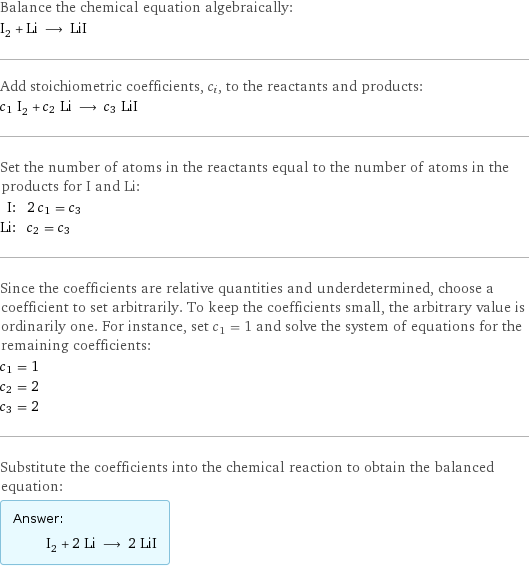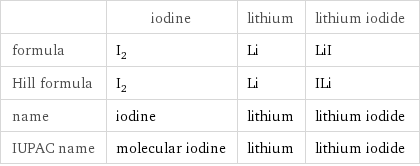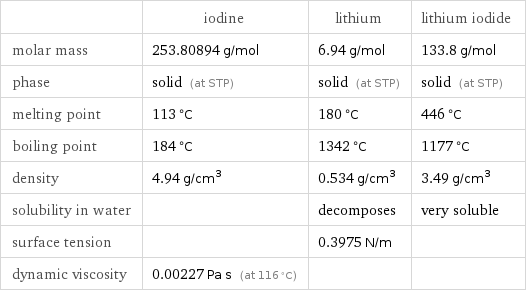Input interpretation

I_2 iodine + Li lithium ⟶ LiI lithium iodide
Balanced equation

Balance the chemical equation algebraically: I_2 + Li ⟶ LiI Add stoichiometric coefficients, c_i, to the reactants and products: c_1 I_2 + c_2 Li ⟶ c_3 LiI Set the number of atoms in the reactants equal to the number of atoms in the products for I and Li: I: | 2 c_1 = c_3 Li: | c_2 = c_3 Since the coefficients are relative quantities and underdetermined, choose a coefficient to set arbitrarily. To keep the coefficients small, the arbitrary value is ordinarily one. For instance, set c_1 = 1 and solve the system of equations for the remaining coefficients: c_1 = 1 c_2 = 2 c_3 = 2 Substitute the coefficients into the chemical reaction to obtain the balanced equation: Answer: | | I_2 + 2 Li ⟶ 2 LiI
Structures

+ ⟶
Names

iodine + lithium ⟶ lithium iodide
Reaction thermodynamics
Enthalpy

| iodine | lithium | lithium iodide molecular enthalpy | 0 kJ/mol | 0 kJ/mol | -270.4 kJ/mol total enthalpy | 0 kJ/mol | 0 kJ/mol | -540.8 kJ/mol | H_initial = 0 kJ/mol | | H_final = -540.8 kJ/mol ΔH_rxn^0 | -540.8 kJ/mol - 0 kJ/mol = -540.8 kJ/mol (exothermic) | |
Equilibrium constant
![Construct the equilibrium constant, K, expression for: I_2 + Li ⟶ LiI Plan: • Balance the chemical equation. • Determine the stoichiometric numbers. • Assemble the activity expression for each chemical species. • Use the activity expressions to build the equilibrium constant expression. Write the balanced chemical equation: I_2 + 2 Li ⟶ 2 LiI Assign stoichiometric numbers, ν_i, using the stoichiometric coefficients, c_i, from the balanced chemical equation in the following manner: ν_i = -c_i for reactants and ν_i = c_i for products: chemical species | c_i | ν_i I_2 | 1 | -1 Li | 2 | -2 LiI | 2 | 2 Assemble the activity expressions accounting for the state of matter and ν_i: chemical species | c_i | ν_i | activity expression I_2 | 1 | -1 | ([I2])^(-1) Li | 2 | -2 | ([Li])^(-2) LiI | 2 | 2 | ([LiI])^2 The equilibrium constant symbol in the concentration basis is: K_c Mulitply the activity expressions to arrive at the K_c expression: Answer: | | K_c = ([I2])^(-1) ([Li])^(-2) ([LiI])^2 = ([LiI])^2/([I2] ([Li])^2)](../image_source/a0482e6e17cf946c6ec7d815edf2bdfa.png)
Construct the equilibrium constant, K, expression for: I_2 + Li ⟶ LiI Plan: • Balance the chemical equation. • Determine the stoichiometric numbers. • Assemble the activity expression for each chemical species. • Use the activity expressions to build the equilibrium constant expression. Write the balanced chemical equation: I_2 + 2 Li ⟶ 2 LiI Assign stoichiometric numbers, ν_i, using the stoichiometric coefficients, c_i, from the balanced chemical equation in the following manner: ν_i = -c_i for reactants and ν_i = c_i for products: chemical species | c_i | ν_i I_2 | 1 | -1 Li | 2 | -2 LiI | 2 | 2 Assemble the activity expressions accounting for the state of matter and ν_i: chemical species | c_i | ν_i | activity expression I_2 | 1 | -1 | ([I2])^(-1) Li | 2 | -2 | ([Li])^(-2) LiI | 2 | 2 | ([LiI])^2 The equilibrium constant symbol in the concentration basis is: K_c Mulitply the activity expressions to arrive at the K_c expression: Answer: | | K_c = ([I2])^(-1) ([Li])^(-2) ([LiI])^2 = ([LiI])^2/([I2] ([Li])^2)
Rate of reaction
![Construct the rate of reaction expression for: I_2 + Li ⟶ LiI Plan: • Balance the chemical equation. • Determine the stoichiometric numbers. • Assemble the rate term for each chemical species. • Write the rate of reaction expression. Write the balanced chemical equation: I_2 + 2 Li ⟶ 2 LiI Assign stoichiometric numbers, ν_i, using the stoichiometric coefficients, c_i, from the balanced chemical equation in the following manner: ν_i = -c_i for reactants and ν_i = c_i for products: chemical species | c_i | ν_i I_2 | 1 | -1 Li | 2 | -2 LiI | 2 | 2 The rate term for each chemical species, B_i, is 1/ν_i(Δ[B_i])/(Δt) where [B_i] is the amount concentration and t is time: chemical species | c_i | ν_i | rate term I_2 | 1 | -1 | -(Δ[I2])/(Δt) Li | 2 | -2 | -1/2 (Δ[Li])/(Δt) LiI | 2 | 2 | 1/2 (Δ[LiI])/(Δt) (for infinitesimal rate of change, replace Δ with d) Set the rate terms equal to each other to arrive at the rate expression: Answer: | | rate = -(Δ[I2])/(Δt) = -1/2 (Δ[Li])/(Δt) = 1/2 (Δ[LiI])/(Δt) (assuming constant volume and no accumulation of intermediates or side products)](../image_source/a3938405f502faef2f562abaaa4ccb86.png)
Construct the rate of reaction expression for: I_2 + Li ⟶ LiI Plan: • Balance the chemical equation. • Determine the stoichiometric numbers. • Assemble the rate term for each chemical species. • Write the rate of reaction expression. Write the balanced chemical equation: I_2 + 2 Li ⟶ 2 LiI Assign stoichiometric numbers, ν_i, using the stoichiometric coefficients, c_i, from the balanced chemical equation in the following manner: ν_i = -c_i for reactants and ν_i = c_i for products: chemical species | c_i | ν_i I_2 | 1 | -1 Li | 2 | -2 LiI | 2 | 2 The rate term for each chemical species, B_i, is 1/ν_i(Δ[B_i])/(Δt) where [B_i] is the amount concentration and t is time: chemical species | c_i | ν_i | rate term I_2 | 1 | -1 | -(Δ[I2])/(Δt) Li | 2 | -2 | -1/2 (Δ[Li])/(Δt) LiI | 2 | 2 | 1/2 (Δ[LiI])/(Δt) (for infinitesimal rate of change, replace Δ with d) Set the rate terms equal to each other to arrive at the rate expression: Answer: | | rate = -(Δ[I2])/(Δt) = -1/2 (Δ[Li])/(Δt) = 1/2 (Δ[LiI])/(Δt) (assuming constant volume and no accumulation of intermediates or side products)
Chemical names and formulas

| iodine | lithium | lithium iodide formula | I_2 | Li | LiI Hill formula | I_2 | Li | ILi name | iodine | lithium | lithium iodide IUPAC name | molecular iodine | lithium | lithium iodide
Substance properties

| iodine | lithium | lithium iodide molar mass | 253.80894 g/mol | 6.94 g/mol | 133.8 g/mol phase | solid (at STP) | solid (at STP) | solid (at STP) melting point | 113 °C | 180 °C | 446 °C boiling point | 184 °C | 1342 °C | 1177 °C density | 4.94 g/cm^3 | 0.534 g/cm^3 | 3.49 g/cm^3 solubility in water | | decomposes | very soluble surface tension | | 0.3975 N/m | dynamic viscosity | 0.00227 Pa s (at 116 °C) | |
Units
